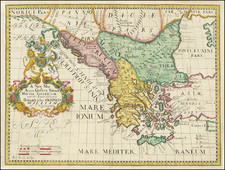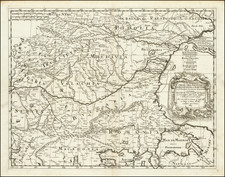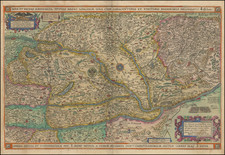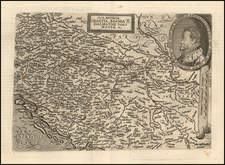Dedicated to the Last Governor of the Kingdom of Serbia, Shortly Before The Battle of Grocka
Rare separately published map of the Theater of War in the region along the Danube River between Belgrade and Vidin (Bulgaria), published in Vienna by Etienne Briffault.
This map shows the "Theater of War in the Banat of Temeswar," centered on the region of the Danube between Belgrade and Vidin and including Timisoara, Arad, and more.
The map is dedicated to George Olivier, the Count of Wallis, who was then serving as commanding officer of the battle and the wartime and last governor of the Kingdom of Serbia, from November 1738 until the accession of the crownland back to the Ottoman Empire in late 1739.
At the lower left corner, the map advertises other maps by Briffault which show the theater of war.
George Olivier, Count of Wallis and Governor of the Kingdom of Serbia
George Olivier, Count of Wallis (1671–1743) was a Vienna born field marshal of Irish descent in the service of the Holy Roman Empire and the Kingdom of the Two Sicilies. Olivier was the last regent of the Habsburg Kingdom of Serbia (1738–1739).
Born into an Irish family, he distinguished himself in Sicily by his capture of Messina. He then commanded on the Rhine (1733), then in Italy and Hungary. He lost the decisive Battle of Grocka against the Ottoman Empire in 1739, thus leading to the peace of Belgrade, which was unfavorable to Austria and thus led to his disgrace.
After his father Ernst Georg Wallis's death in 1689 in the Nine Years' War during the Siege of Mainz, George Olivier became a page at the Vienna court and just one year later became a lieutenant in the imperial army. In 1697 he fought as a hauptmann at the battle of Zenta. During the War of the Spanish Succession (1701–14) he first served in northern Italy, then from 1707 in the conquest of Naples. He also served in Spain until 1713 and by the end of the war had reached the rank of Feldmarschall-Leutnants.
He fought again in the Ottoman–Venetian War (1714–1718), under the command of Prince Eugene of Savoy at the Battle of Petrovaradin and at the sieges of Temesvár and Belgrade. The following year he was put in command of three regiments and posted to operations in Naples. In the War of the Quadruple Alliance (1718–20) he fought in the Austrian army on Sicily, being wounded in the struggle for Messina but later becoming governor of that city's fortress until 1727, when he returned to Austria.
When the Anglo-Spanish War (1727–1729) threatened to escalate the Holy Roman Emperor ordered Olivier back to Sicily to ready the island's defenses. In the War of the Polish Succession (1733–1735/38) he served against France in northern Italy. He even took overall command of the whole Austrian force there for a brief period.
In the Austro-Russian–Turkish War (1735–1739) he commanded an Austrian corps and was shortly afterwards promoted to field marshal. In the last year of the war he was the Austrian army's supreme commander but he lost the decisive battle of Grocka on July 22, 1739. Only a week after the battle Austria was forced to sign the Peace of Belgrade, losing large swathes of territory to the Ottoman Empire.
Olivier was one of the main culprits for the defeat. He was tried with other generals before a war tribunal and on February 22, 1740 was sentenced to imprisonment at the fortress at Spielberg. On the death of Charles VI he was pardoned by Maria Theresa of Austria. He then spent his final years on his lands, often being consulted by Vienna on military matters. The war against the Turks, however, had caused lasting damage to his brilliant military reputation, as is reflected in later historians' assessments of him.
Rarity
The map is extremely rare on the market. We note a single example offered at Reiss & Sohn in 2010, but not printed on linen.
OCLC lists examples in the British Library (King George III copy), Institut fur Donauschwabische, Bibliotheque National de France, Landsbibliothek Darmstadt, and Bayerische Staatsbibliothek, none of which mention being printed on linen.









![[ Western Bulgaria ] Des Königreichs Bulgarien Westliche Haelfte Nro. 15](https://storage.googleapis.com/raremaps/img/small/102185.jpg)


![(Second World War - Soviet Invasion of Romania) [Troop Movements in the Vicinity of Gura Humorului]](https://storage.googleapis.com/raremaps/img/small/89328.jpg)

